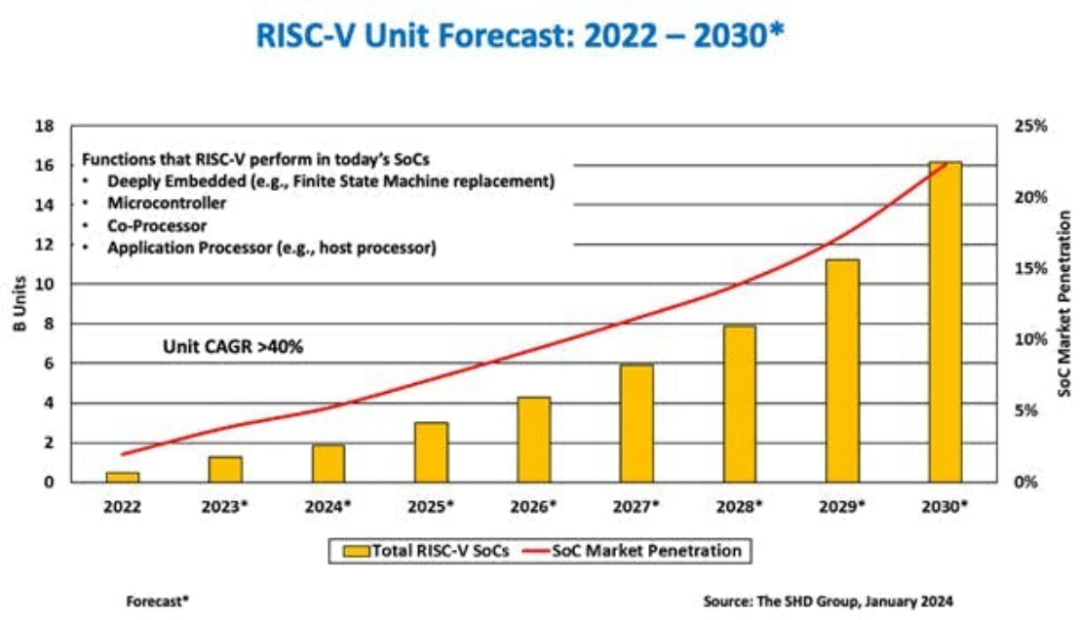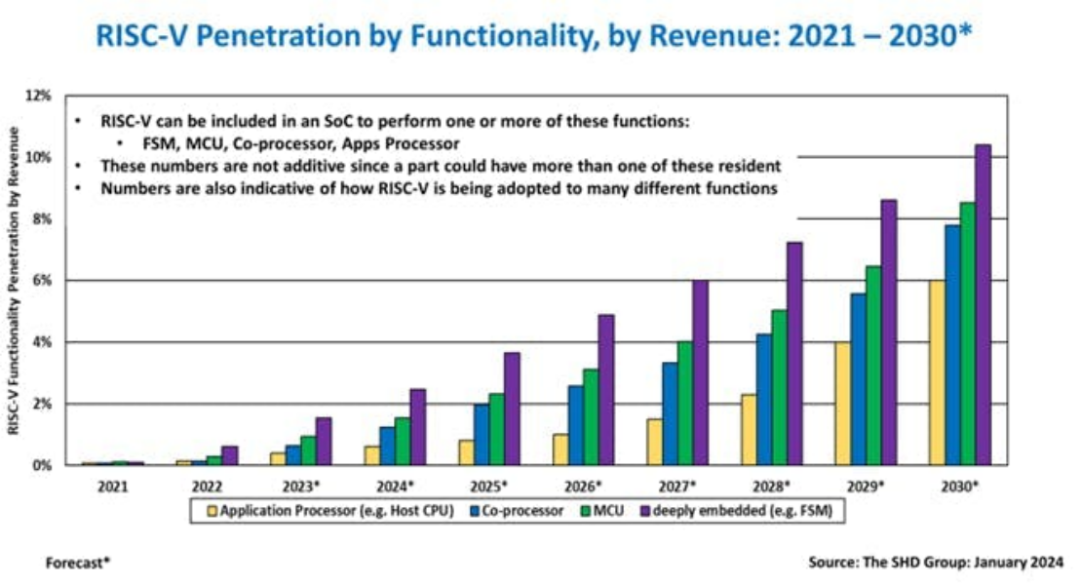 SoC design has significantly shifted towards RISC-V architecture.This article focuses on its impact on the semiconductor industry and its role in promoting technological development, innovation, and flexibility.
SoC design has significantly shifted towards RISC-V architecture.This article focuses on its impact on the semiconductor industry and its role in promoting technological development, innovation, and flexibility. The rise of the RISC-V instruction set architecture (ISA), managed by RISC-V International, coincides with an exciting time in the semiconductor industry. The creation of new technologies is driving advancements across various fields, including artificial intelligence, the Internet of Things, the automotive industry, and even space exploration.The emergence of these innovative product designs aligns with the growing preference for the new ISA among SoC designers (Figure 1). In this converging moment, the RISC-V ISA stands out, providing designers with a broader selection of CPUs, NPUs, and IP cores for their new product designs in today’s rapidly evolving technological environment.
The rise of the RISC-V instruction set architecture (ISA), managed by RISC-V International, coincides with an exciting time in the semiconductor industry. The creation of new technologies is driving advancements across various fields, including artificial intelligence, the Internet of Things, the automotive industry, and even space exploration.The emergence of these innovative product designs aligns with the growing preference for the new ISA among SoC designers (Figure 1). In this converging moment, the RISC-V ISA stands out, providing designers with a broader selection of CPUs, NPUs, and IP cores for their new product designs in today’s rapidly evolving technological environment.
 What is RISC-V?
What is RISC-V?
RISC-V is an open-source ISA that represents a significant shift in the design and development of microprocessors and SoCs. RISC-V is freely available for anyone to access, modify, and distribute, making it an attractive option.Its design philosophy emphasizes simplicity and efficiency, utilizing a streamlined set of instructions that can be executed faster and consume less power. This openness and flexibility foster innovation and collaboration, as companies and developers can build customizable processors tailored to their specific needs without incurring licensing fees and restrictions associated with proprietary ISAs.Until recently, Arm, as the primary ISA provider, operated a business model that controlled access. This created a closed environment, making the company a dominant force in the semiconductor industry. This control also allowed Arm to generate revenue by charging licensing fees to manufacturers using its technology while protecting its proprietary designs and innovations from unauthorized use or modification.
 Advantages of the RISC-V Open Model
Advantages of the RISC-V Open Model
Today, the landscape of multi-core SoC design has shifted from homogeneity to heterogeneity, with multiple ISAs appearing on any given chip. This provides designers with the opportunity to consider and evaluate competing ISAs and vendors. In this environment, CPU cores can now perform a range of tasks, and these cores do not necessarily come from the same IP vendor.Figure 2 shows a range of tasks performed by RISC-V cores in contemporary SoCs, with programmable alternatives for deeply embedded finite state machines being the largest use case today. Following closely are MCU and coprocessor functionalities. Interestingly, as IP vendors introduce more powerful and higher-performance RISC-V CPU cores to the market, the functionality of “application processors” is becoming increasingly popular.This indicates that the market is continuously innovating to meet the growing demand for more features.The competition among RISC-V CPU IP vendors is fierce and has spurred innovation.Unlike proprietary architectures, the RISC-V ISA is publicly available, and the RISC-V standard is developed and managed by RISC-V International. Through collaboration among multiple company RISC-V member committees, extensions to the core ISA are created, which can then be customized according to vendor and market needs.As a result, dedicated domain solutions that meet the precise needs of different applications can be developed more quickly. This flexibility aligns with the growing demand for customized silicon solutions that meet specific functional requirements, thereby enhancing performance and efficiency for target use cases.The open model of RISC-V marks a significant shift in the industry, enabling companies to adopt an ISA that is not restricted by any single vendor. Even software developed according to RISC-V standards can run on devices from different manufacturers. This interoperability fosters a competitive environment and stimulates innovation while also reducing risks and costs for companies.
Interestingly, as IP vendors introduce more powerful and higher-performance RISC-V CPU cores to the market, the functionality of “application processors” is becoming increasingly popular.This indicates that the market is continuously innovating to meet the growing demand for more features.The competition among RISC-V CPU IP vendors is fierce and has spurred innovation.Unlike proprietary architectures, the RISC-V ISA is publicly available, and the RISC-V standard is developed and managed by RISC-V International. Through collaboration among multiple company RISC-V member committees, extensions to the core ISA are created, which can then be customized according to vendor and market needs.As a result, dedicated domain solutions that meet the precise needs of different applications can be developed more quickly. This flexibility aligns with the growing demand for customized silicon solutions that meet specific functional requirements, thereby enhancing performance and efficiency for target use cases.The open model of RISC-V marks a significant shift in the industry, enabling companies to adopt an ISA that is not restricted by any single vendor. Even software developed according to RISC-V standards can run on devices from different manufacturers. This interoperability fosters a competitive environment and stimulates innovation while also reducing risks and costs for companies.
 Multi-Company Support for Flexible RISC-V ISA
Multi-Company Support for Flexible RISC-V ISA
The flexibility of RISC-V makes it an increasingly attractive choice for developing and deploying silicon solutions across multiple performance ranges. In the RISC-V space, multiple CPU IP vendors form a community, with many companies simultaneously designing new solutions.Moreover, RISC-V International has over 80 active committees that continue to enhance the ISA through a multi-company process in a standardized manner. This collective effort leads to rapid development of diverse products implementing the ISA, thereby accelerating performance improvements and providing customers with more choices.Support for a unified RISC-V ecosystem is continuously growing and has become quite robust, with multiple companies already offering solutions. It encompasses a wide range of technologies and components, supporting everything from hardware design to software development.For instance, more building blocks needed by SoC designers in their design work are now in place and sourced from multiple origins. Additionally, if a team requires support in a specific area of their design work, it is now likely to be available. Thus, it enhances the confidence of the design community in RISC-V technology.
 Providing More Choices for the Semiconductor Design Community
Providing More Choices for the Semiconductor Design Community
Now is a great time for the semiconductor industry, as the continuous increase in innovation is giving rise to newer and more powerful applications and silicon solutions. RISC-V is driving the arrival of a new era by providing more design choices, encouraging competition, and facilitating the evolution of ISAs.The aforementioned areas indicate the growing importance of the RISC-V ISA to the semiconductor design community and the broader market. This environment ensures that SoC designers can freely choose from a wide range of solutions, enabling them to build more advanced systems.The SHD Group’s research report, “RISC-V Market Report: Application Forecast in a Heterogeneous World,” analyzes the current and future application opportunities of RISC-V in terms of functionality, device types, product categories, and even process geometries. The report emphasizes the fact that today’s SoC designs are no longer homogeneous. Instead, designs now tend to utilize multiple architectures that provide different functionalities from numerous IP vendors, all residing on the same silicon — a heterogeneous world.*Disclaimer:This article is an original work by the author, compiled from electronic design.The content of the article reflects the author’s personal views, and Luko Verification reproduces it solely to convey a different perspective, not representing Luko Verification’s endorsement or support of the viewpoint. If there are any objections, please feel free to contact Luko Verification.